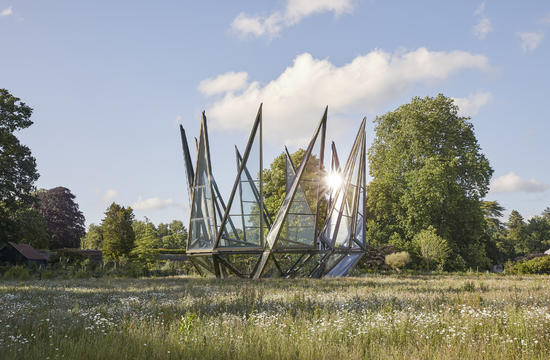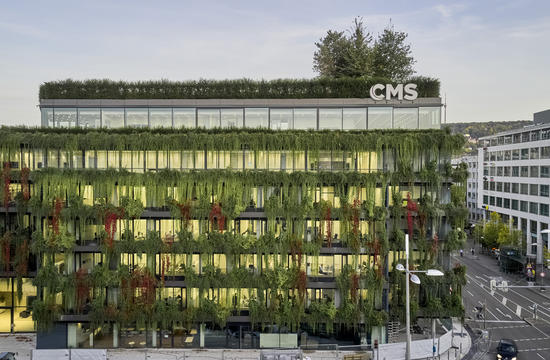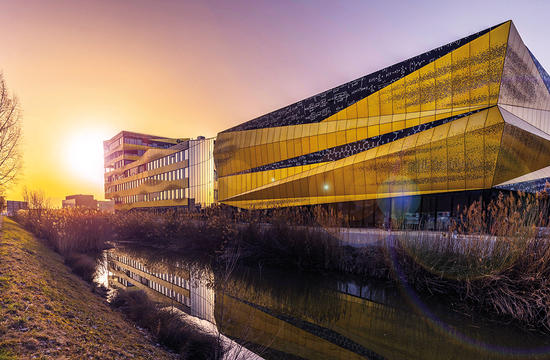A day’s work in eternal Alpine ice
Text: Lars Thieleke
Office getting a bit cramped? Noisy workmates? Anyone complaining about their workplace might like to swap jobs with Martin Moser. He is
a fitter working in Antarctic-like conditions on Germany’s highest building site, where he and his colleagues are busy modernising the former Eibsee cable-car line up to Germany’s tallest mountain, the Zugspitze. We went with Martin, to see what it’s like to spend a working day almost two miles up and at temperatures of 20 below zero.
“Thinking creates fear. Fear is bad. So I don’t do that much thinking.”, says Martin Moser as he sinks a powered screwdriver into the curtain wall. He works on scaffolding at an altitude of almost 3,000 metres (i.e. the best part of two miles). The structure is encased in so much ice that it looks like some mythical giant beast. There is indeed something odd about it all; being surrounded by snow up here on Germany’s highest mountain, as people saunter around in swimming trunks and bikinis by the Eibsee, the lake in the valley below. When Martin packs his rucksack in the morning to take the cable-car up to the peak, he includes just the essential equipment for the job in hand: skiing goggles to prevent snow blindness, factor-50 sun cream and thermal underwear. “I’m not sensitive to the cold. Four body-layers are enough. But some of my workmates wear three pairs of socks to stop their toes dropping off”, explains the 33-year-old fitter.

Permafrost at the mountain station. It is not uncommon to see temperatures of 20 below zero around here, so today’s temperature of -5°C makes it Mediterranean by comparison, although Martin still has to cope with the icy, dry wind. “I change my thermal gloves several times a day, and regularly apply Nivea cream to stop my hands chapping while I’m working.” His fingers are not always fully at his command, especially when he has to take off his frozen gloves to handle small screws. The cold is not the only serious hazard he has to deal with in the course of every working day however: “You need to stay really focused while you’re working up here on the scaffolding, so as not to slip or lose your balance in the wind. You also need to be naturally sure-footed and not afraid of heights. And you have to get used to the thin air, as the lack of oxygen can dull your senses at first.” says the father of three. Martin doesn’t set much store by lucky charms, but if you ask him whether he entrusts his welfare to any superstitious ritual, he replies jokingly: “Not changing your underwear more than once a month.”

By the time the spring of 2015 saw the modernisation of the mountain and valley stations of the Eibsee cable-car line (which is now more than 50 years old), contracts for the static engineering and draft architectural design had been awarded to Baucon of Vienna and Hasenauer Architects of Saalfelden respectively The man in charge of design was Sebastian Kroesen, whose ideas held sway from the very beginning. He proposed the inclusion of a spacious viewing terrace at the summit and recommended an extension to the restaurant, thereby allowing visitors to enjoy fully the north-facing panorama. According to Mr Kroesen, visitors to the summit of the Zugspitze are mainly interested in two things: the view from the top and their experience of their stay – which includes the dining on offer.
Intensifying the summit experience. Putting this idea into practice required a daring overhang on the north side of the ridge, protruding over the incoming cable line with its angle of approximately 45°. The new cable-car line had to be positioned in front of the north ridge, in an area where fissures in the rock and permafrost prevent the direct inclusion of foundations in the mountain’s structure. Baucon’s sophisticated static engineering made this possible. The structure now handles the considerable tensile forces of the cable line and overhang by way of the entire existing building, right around to the other side of the summit ridge.

The tricky factor in all this is that while the static loads created by the cable-car line and the corresponding load capacities were relatively easy to calculate, the calculations for wind and snow load in such an exposed place varied significantly from the norm. A firm called Wacker Wind Engineers therefore had to use a wind-tunnel model to try out various geometrical configurations for the area of the curtain wall. The overarching question in this respect was how to incorporate an insulating shell into a steel structure that has to cope with such forces. Sebastian Kroesen’s solution was to leave the large curved sections cold, as they provide access for the cable-car line, and cannot be enclosed. His design then envisaged the inclusion of heated rooms in this cold steel structure, on the box-in-a-box principle, with as little direct contact between them as possible.
The mountain station still fails to feel like a warm room to Martin after four months, but more like a normal, everyday building site. Well almost. Given that tourism needs to continue uninterrupted, one of the Alpine-acclimatised fitters has to go up in the crane every morning and remove the ice with a hot-air blower, to eliminate any danger of visitors being speared by falling icicles. There is at least a crane at the summit. The concrete for the crane’s foundations was flown up the mountain by helicopter, and the first anchoring points were created with a technique involving high-performance manual power drills, designed to penetrate 15 metres into the rock, before a large, specially chartered Russian helicopter flew in the crane components. An extra piece of equipment was installed alongside the crane to help normalise building work at the summit: a cable-car line for materials. It runs in parallel with its passenger-carrying counterpart, taking tools, steel profiles and material up to the mountain station. It is to be dismantled when it becomes redundant at the end of 2017.

Over a stone (8 kg) lighter is how Martin reports his weight after five weeks up the Zugspitze, despite his daily lunch diet of curried sausage and chips. “I just burn it all straight off.” he says, adding “The restaurant gives us their left-over pretzels every evening, and we have an all-day, all-you-can-eat deal on gummy bears” (the German version of jelly babies). He takes the downbound cable-car at 7 pm every evening, and always looks forward to a hot shower in his hotel room. He occasionally allows himself a treat. “I’m usually quite tired when evening comes, but I will sometimes go out for a beer. Whenever I do, a pint of draught Augustiner is what does the trick.”

Which curtain wall withstands wind and snow? The mountain and valley stations of the Zugspitz cable-car line are equipped with the systems THERM+ A-I 56 mm and THERM+ H-I 56 mm, along with a steel substructure. Handling slopes and roof glazing in the same way. This is where one of the strengths of our range of systems comes to the fore. The modular design of its various components allows virtually limitless combinations.





